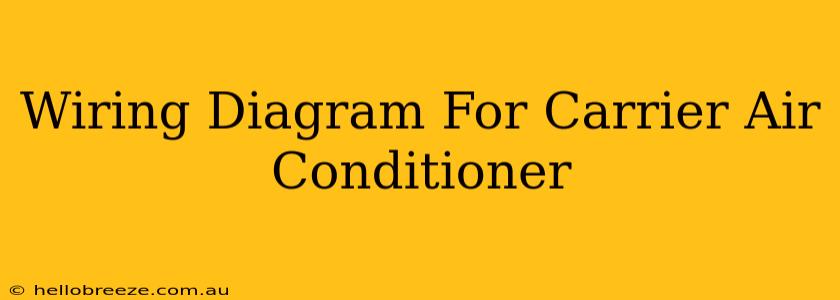Finding the right wiring diagram for your Carrier air conditioner is crucial for installation, maintenance, and troubleshooting. This guide will help you understand how to locate and interpret these diagrams, ensuring safe and efficient operation of your unit. We'll cover different Carrier models, common wiring configurations, and safety precautions.
Understanding Carrier Air Conditioner Wiring Diagrams
Carrier air conditioners, like all HVAC systems, rely on intricate wiring to control various components. The wiring diagram acts as a roadmap, illustrating how these components connect and function together. These diagrams are essential for:
- Installation: Correct wiring ensures the unit operates as designed.
- Troubleshooting: Identifying faulty wires or connections helps diagnose problems quickly.
- Maintenance: Proper wiring is vital for safe and efficient maintenance procedures.
- Upgrades: If you're upgrading components, the diagram helps you connect new parts correctly.
Types of Carrier Air Conditioner Wiring Diagrams
The specific wiring diagram you need depends on your Carrier air conditioner's model and features. These diagrams can be found in several places:
- Unit's Data Plate: Often located on the unit itself, the data plate might include a simplified diagram or a model number to help you find a more comprehensive one.
- Owner's Manual: The owner's manual is the best place to start your search. It contains detailed diagrams and wiring instructions specifically for your model.
- Carrier Website: Carrier's website might offer access to wiring diagrams, either through searching for your model number or by accessing their technical documentation section.
- HVAC Technician: If you're uncomfortable working with electrical wiring, always consult a qualified HVAC technician. They have access to extensive resources and expertise.
Deciphering the Diagram: Key Components and Symbols
Carrier air conditioner wiring diagrams typically use standardized symbols to represent different components. Familiarizing yourself with these symbols is key to understanding the diagram:
- Compressor: Usually represented by a large motor symbol.
- Condenser Fan Motor: Often shown as a smaller motor symbol connected to the condenser coil.
- Evaporator Fan Motor: Similar to the condenser fan motor but associated with the indoor unit.
- Reversing Valve (for heat pumps): A special valve controlling the refrigerant flow for heating and cooling.
- Capacitors: Represented by parallel lines indicating stored electrical energy.
- Transformers: Shown as two coils with an arrow indicating energy transfer.
- Thermostat: Often represented by a simple temperature gauge symbol.
- Power Supply: Usually shown as a power source symbol with positive (+) and negative (-) terminals.
Note: Wire colors are crucial! Pay close attention to the wire color codes indicated on the diagram and on your unit's wiring. Incorrect wiring can lead to malfunctions or serious damage.
Safety Precautions When Working with Wiring
Working with electrical wiring can be dangerous. Always take these precautions:
- Turn off the power: Before starting any work, disconnect the power supply to the air conditioner at the breaker box.
- Use appropriate tools: Use insulated tools to avoid electrical shocks.
- Consult a professional: If you're unsure about any aspect of the wiring, contact a qualified HVAC technician. Incorrect wiring can void warranties and create serious hazards.
- Understand the voltage: Be aware of the voltage of the system you're working with to take appropriate safety measures.
Finding Specific Diagrams for Different Carrier Models
While the general principles remain consistent, specific wiring diagrams vary across different Carrier air conditioner models. Always refer to the documentation for your specific unit. The model number is crucial for finding the correct information.
By carefully following these guidelines and understanding the importance of safety, you can effectively use Carrier air conditioner wiring diagrams to ensure the safe and efficient operation of your unit. Remember, when in doubt, consult a professional HVAC technician.

